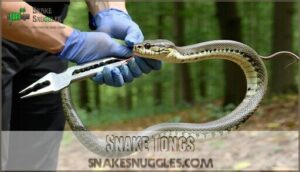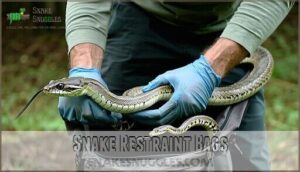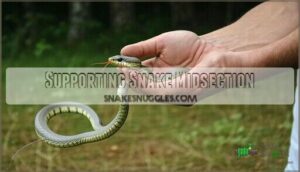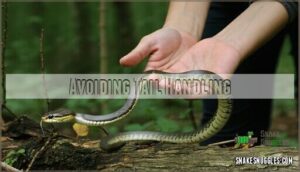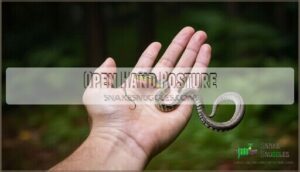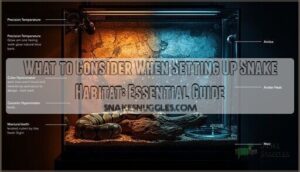This site is supported by our readers. We may earn a commission, at no cost to you, if you purchase through links.
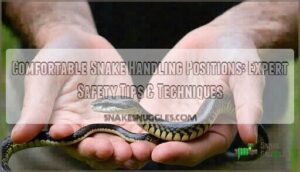
Position yourself at the snake’s midsection rather than grabbing the head or tail, which can stress your reptilian friend and trigger defensive behavior.
Keep your movements smooth and deliberate, matching the snake’s natural flow to build trust and confidence.
Use both hands to distribute weight evenly across the snake’s body, allowing it to move naturally while you maintain gentle control.
This technique works like a dance between handler and snake, creating a calm experience for both parties.
The secret lies in understanding each species’ unique temperament and body mechanics.
Table Of Contents
- Key Takeaways
- Safe Handling Techniques
- Reducing Snake Stress
- Essential Handling Tools
- Handling Different Species
- Optimal Handling Positions
- Frequently Asked Questions (FAQs)
- How to get a snake comfortable with being held?
- Is it better to grab a snake by the head or tail?
- How to gently hold a snake?
- Whats the best room temperature for handling sessions?
- How should pregnant snakes be positioned during handling?
- Can snakes be handled during their shedding cycle?
- Should juveniles be handled differently than adults?
- Conclusion
Key Takeaways
- You’ll master snake handling by supporting their midsection with both hands, never grabbing the head or tail which causes stress and defensive reactions.
- You’ll keep sessions short at 10-15 minutes with slow, deliberate movements that match your snake’s natural flow to build trust and confidence.
- You’ll use proper equipment like snake hooks, tongs, and gloves to maintain safe distances while giving you complete control during handling sessions.
- You’ll create calm environments with proper temperature (70-78°F) and quiet spaces, limiting handling time to prevent overwhelming your reptilian companion.
Safe Handling Techniques
You’ll master snake handling faster when you use proper techniques that keep both you and the snake comfortable.
The right approach combines essential safety tools with calm, confident movements that reduce stress for everyone involved.
Using Snake Hooks
Snake hooks put you in the driver’s seat for safe handling.
These versatile snake handling tools keep dangerous fangs at arm’s length while giving you complete control.
Here’s your hook mastery checklist:
- Hook Size: Match hook length to your snake—24-40 inches for most species
- Hook Material: Choose aluminum for lightweight durability and easy Hook Maintenance
- Lifting Technique: Slide under midsection, never scrape or jerk upward
- Guiding Snakes: Use slow, deliberate motions to direct movement safely
- Snake Hook Use: Keep the head pointed away from you during transfers
Professional snake handling equipment reduces injury rates by over 60% compared to bare-handed methods.
Professional snake handling equipment puts distance between you and danger while maintaining complete control.
Mastering proper snake handling techniques, including understanding snake handling safety, is vital for minimizing risks and ensuring a safe experience.
Choosing Right Gloves
You’ll want quality hand protection that balances safety with finger dexterity.
Leather gloves offer solid bite resistance up to 340 psi, while Kevlar-lined options boost puncture protection by 60%.
Look for reinforced fingertips and textured grip texture surfaces that reduce slip risk by half.
Proper glove sizing prevents dangerous shifting at seams.
Wrist support from gauntlet-style designs protects your forearms from strikes.
When handling snakes, considering leather glove options is vital for superior protection.
Handling Large Snakes
Heavy lifting demands technique over strength when handling large snakes.
You’ll need longer hooks and tongs for bigger species, plus extra hands for support.
Position one hand near the head, another at mid-body, letting the snake’s weight distribute naturally.
Never attempt solo handling of snakes over six feet—your safety and the snake’s comfort depend on proper snake support techniques and gentle lifting methods for successful heavy snake management.
Reducing Snake Stress
Creating a calm environment and gentle handling approach will keep your snake relaxed and comfortable during interaction sessions.
You’ll reduce stress by moving slowly, supporting their body properly, and limiting handling time to prevent overwhelming your reptilian companion with gentle handling.
Calm Environment
Creating the perfect calm environment is like setting the stage for a smooth performance.
You’ll want quiet spaces away from household chaos, where temperature control maintains 72-78°F and humidity levels stay around 50-60%.
Add snake hideaways with gentle lighting to create peaceful surroundings.
This calm environment reduces stress signals, making your gentle touch more effective for snake calmness maintenance.
Minimizing Handling Time
Ten-minute sessions work better than marathon handling sessions.
Quick sessions build trust faster than exhausting marathons ever could.
Brief sessions reduce snake handling stress while building trust gradually.
Keep interactions short and sweet – your snake will appreciate the gentle touch and calm approach.
Quick transfers between hands prevent fatigue.
Watch for stress signs like defensive posturing to determine ideal handling duration.
Understanding proper snake stress reduction is key to a calm and safe handling experience with a focus on gentle touch.
Avoiding Sudden Movements
Slow movements are your secret weapon for snake handling success.
Quick motions trigger defensive behavior, while a gentle lift and calm handling keep your snake relaxed.
Use smooth transfers between hands in quiet environments.
Think of yourself as moving through honey – deliberate and controlled.
This snake handling calmness prevents strikes and builds trust through consistent, slow movements that demonstrate your understanding of snake behavior.
Essential Handling Tools
You’ll need the right tools to handle snakes safely and reduce stress for both you and your serpentine friend.
Professional-grade equipment like snake tongs, restraint bags, and secure enclosures aren’t just fancy accessories—they’re your insurance policy against bites and escapes.
That could turn a routine handling session into an emergency room visit, highlighting the importance of having the right equipment to prevent such incidents.
Snake Tongs
When choosing snake tongs for safe handling, you’ll want 24-60 inch aluminum models with rubberized jaws.
Professional tongs reduce bite risk by 67% compared to bare-hand methods.
Master these tong safety fundamentals for effective snake control:
- Grip mid-body only – never grasp head or tail to prevent spinal injury
- Support snake’s weight with hooks or hands to avoid vertebrae damage
- Clean between uses to maintain grip reliability and prevent contamination
- Match tong size to snake species – larger snakes need robust models
- Practice first on non-living objects before handling live reptiles
Proper handling techniques require gentle but firm pressure.
Tool maintenance guarantees your equipment won’t fail when you need snake control most.
Effective snake handling also involves understanding the importance of proper snake handling equipment to minimize risks and guarantee a safe experience.
Snake Restraint Bags
Snake restraint bags provide secure containment during transport and handling protocols.
These durable bag materials prevent escape while allowing safe snake restraint techniques.
Choose appropriate bag sizes for your species – larger snakes need bigger bags.
Quality snake handling gear includes reinforced seams and secure closures.
Snake safety measures require proper restraint bag selection for effective snake transport and escape prevention protocols.
Proper snake handling involves using the right snake restraint equipment to minimize risks.
Secure Enclosures
Every successful handler knows that bulletproof enclosures are your first line of defense against chaos.
Quality enclosure materials like reinforced glass or sturdy plastic, combined with reliable locking systems, create an escape-proof fortress.
Proper ventilation design maintains airflow while preventing squeeze-outs, and humidity control keeps your snake comfortable.
Remember, secure doors and rigorous snake proofing today prevent midnight surprise visits tomorrow.
When designing a snake’s home, consider the importance of proper snake enclosure materials to guarantee safety and comfort.
Handling Different Species
Different snake species require unique handling approaches based on their temperament and natural behaviors.
You’ll find that docile species like corn snakes and ball pythons are forgiving partners for beginners, while defensive species need extra patience and respect for their boundaries.
Docile Species Handling
Certain docile breeds like corn snakes and ball pythons practically handle themselves once you master basic snake handling techniques.
Their calm snake temperament makes species selection easier for beginners.
Use gentle restraint with midbody support, maintaining a relaxed gentle grip while allowing natural movement.
Understanding snake behavior helps maintain snake calmness during sessions, as these breeds typically settle quickly in experienced hands.
Defensive Species Handling
Defensive species require specialized handling techniques that prioritize safety and stress reduction.
When approaching defensive snakes, use snake hooks to maintain distance while gently tapping to assess snake temperament.
These species often display defensive postures like coiling, hissing, or striking.
Understanding species behavior helps you anticipate reactions and adjust snake handling protocols accordingly.
Implement gradual snake behavior understanding through consistent, calm interactions that promote stress reduction over time.
To facilitate safe interactions, it’s vital to study snake handling basics and adapt techniques to the specific species being handled, ensuring safe interactions and promoting stress reduction.
Venomous Species Precautions
When dealing with venomous species, you’re playing with fire.
Professional venomous snake handling demands specialized equipment like puncture-resistant gloves and face shields for spitting cobras.
Never work alone—venom detection skills and proper venomous ID are life-savers.
Keep antivenom accessible and follow strict safety protocols.
Snake bite prevention starts with understanding snake behavior and maintaining distance through tubes or hooks.
Optimal Handling Positions
Proper snake handling positions make the difference between a calm snake and a stressed one that might bite.
You’ll want to support your snake’s body correctly while keeping both you and your scaly friend comfortable during handling sessions.
Supporting Snake Midsection
You’ll master control by placing your hands beneath the snake’s thickest section.
Midsection support prevents spinal injury while maintaining snake balance during gentle lifting.
Position one hand under the mid-body for stability, distributing weight evenly.
This body alignment technique reduces stress and escape attempts.
Proper snake holding methods require supporting the midsection continuously, creating trust through consistent hand placement and midsection care.
This approach ensures gentle lifting and safe handling of the snake.
Avoiding Tail Handling
While supporting the snake’s midsection keeps it comfortable, you’ll want to avoid grabbing the tail at all costs. Tail Grip disrupts Snake Balance and triggers immediate stress responses that can escalate into defensive behavior.
Handling Tips for avoiding tail contact:
- Midsection Lift technique prevents tail panic reactions
- Body Support distributed across torso maintains natural posture
- Snake handling safety requires hands positioned away from tail area
- Snake handling precautions include never using tail as lifting point
- Snake handling gentle lift focuses on mid-body placement only
Snake handling body support works best when you respect the animal’s anatomy. Think of it like picking up a rope – grabbing the end creates instability. Snake handling stress signs often appear immediately after improper tail contact, including rapid coiling and defensive posturing.
Open Hand Posture
While proper tail handling matters, your Hand Placement determines success.
Use open hand posture with relaxed fingers spread like tree branches. Keep your Palm Support flat and Wrist Alignment straight for ideal snake handling confidence.
This Finger Position allows natural movement while maintaining Arm Relaxation. Your snake handling techniques improve dramatically when you master these snake handling safety fundamentals.
Frequently Asked Questions (FAQs)
How to get a snake comfortable with being held?
Start with slow, gentle handling sessions lasting 10-15 minutes once or twice weekly.
Support your snake’s midsection with both hands, allowing natural movement while maintaining calm, deliberate motions to build trust gradually.
Is it better to grab a snake by the head or tail?
Neither option works well for snake handling.
You should never grab a snake by its head or tail, as both methods cause stress and trigger defensive reactions.
Instead, gently support the snake’s midsection with both hands to keep it secure and comfortable.
How to gently hold a snake?
Gently grasp your snake around its midsection using both hands for support.
Let it move freely between your palms while maintaining loose contact, never squeezing or gripping tightly around its body.
Whats the best room temperature for handling sessions?
You’ll want room temperatures between 70-78°F for comfortable handling sessions. This range keeps your snake calm and relaxed, preventing stress from temperature extremes that could trigger defensive behaviors.
How should pregnant snakes be positioned during handling?
Picture a pregnant ball python coiling defensively when handled incorrectly – you must support her body weight evenly.
Always cradle pregnant snakes horizontally with both hands supporting her midsection, never lifting by head or tail to prevent stress and potential harm.
The key to safe handling is to ensure that you are handling the snake in a way that prevents harm.
Can snakes be handled during their shedding cycle?
You shouldn’t handle snakes during shedding since their skin becomes sensitive and vision gets cloudy. Wait until they’ve completed the shed cycle for safer, less stressful handling sessions.
Should juveniles be handled differently than adults?
Juveniles show 15% more defensive behavior than adults, making them trickier to handle.
You’ll need extra patience with young snakes since they’re naturally more skittish and defensive than their calmer adult counterparts.
Conclusion
Mastering comfortable snake handling positions transforms nervous encounters into confident interactions.
You’ll discover that proper technique reduces stress for both you and your scaly companion while preventing accidental bites or injuries.
Remember to support the snake’s body weight evenly, move slowly, and respect each species’ unique temperament.
With practice, these comfortable snake handling positions become second nature, making every handling session safer and more enjoyable for everyone involved, which is the key to confident interactions.


